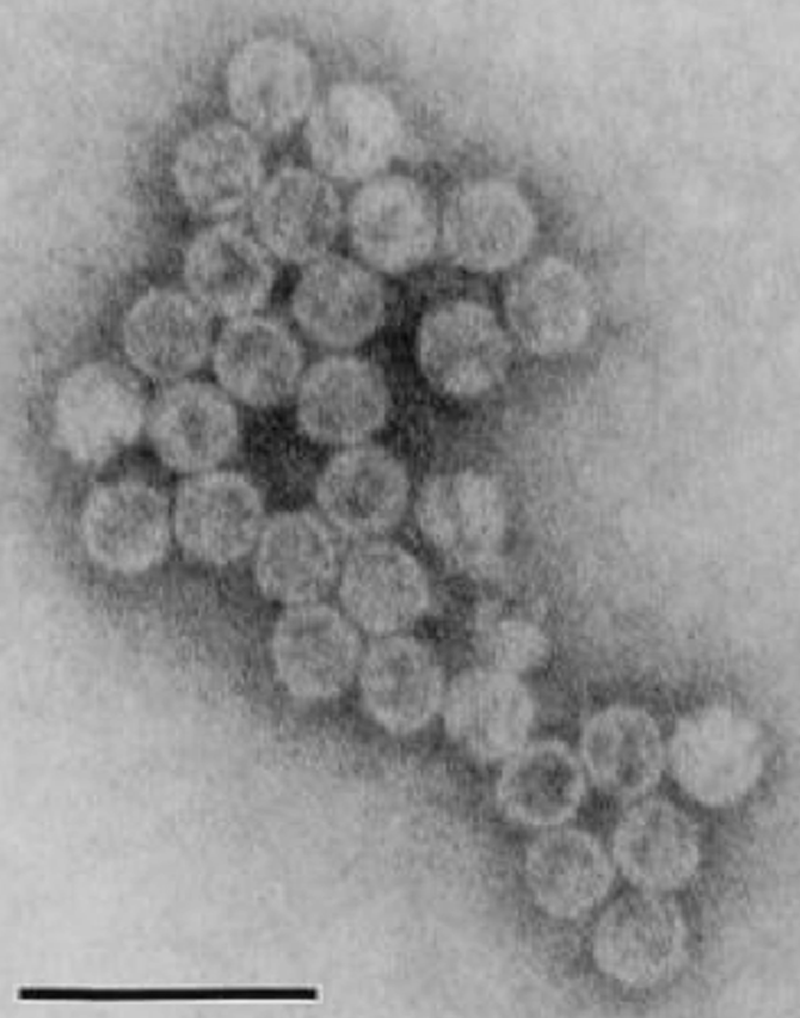Family: Partitiviridae
Genus: Cryspovirus
Distinguishing features
Members of the genus Cryspovirus infect apicomplexan protozoa of the genus Cryptosporidium (Leoni et al., 2006, Nibert et al., 2009) and are largely transmitted by intracellular means during cell division and gamete fusion. Their genomes comprise two dsRNA segments of similar sizes that are individually encapsidated in separate particles.
Virion
Morphology
Virions are isometric and nonenveloped, and about 31 nm in diameter as visualized by negative-staining and transmission electron microscopy (Figure 1 Cryspovirus). The capsids appear single-layered and thin, with short protrusions on their surfaces.
 |
| Figure 1 Cryspovirus. Electron micrograph of Cryptosporidium parvum virus 1 particles. Particles were gradient-purified from C. parvum strain KSU-1, negatively-stained with uranyl acetate and visualized by transmission electron microscopy. Bar represents 100 nm. (Image is reproduced from Khramtsov and Upton (2000) (Khramtsov and Upton 2000) with permission of the American Society for Microbiology.) |
Physicochemical and physical properties
Virions have a buoyant density of 1.39–1.44 g cm−3 in CsCl gradients.
Nucleic acid
Viral particles contain two linear dsRNA segments of approximately 1.4 and 1.7 kbp, which are separately encapsidated. The complete sequence of both genome segments from a single strain of the species Cryspovirus cryptosporidii was determined by Vong et al. (2017), who proposed that strain CSpV1-Iowa should be substituted for CSpV1-KSU1 as the exemplar strain of the species and genus, since the previously reported sequences of the latter appear to be terminally truncated (Vong et al., 2017). Additional dsRNA segments have not been reported in studied isolates of Cryptosporidium parvum virus 1.
Proteins
There is a single major coat protein (CP) of approximately 37 kDa and an RNA-dependent RNA polymerase (RdRP) of around 62 kDa. Virion-associated RNA polymerase activity is present.
Genome organization and replication
Each genome segment is monocistronic: dsRNA1 codes for the RdRP and dsRNA2 codes for the major CP. The virion-associated RdRP catalyzes in vitro end-to-end transcription of each dsRNA to produce mRNA by a semi-conservative mechanism.
Biology
Infections of the Cryptosporidium host cells appear to be largely latent. Although Cryptosporidium species are pathogens of humans and other vertebrates, there are so far no well-established examples in which parasite pathogenicity is either positively- or negatively-modulated by cryspovirus infection. Virions are disseminated in nature within Cryptosporidium oocysts, which are shed profusely from Cryptosporidium-infected animals. A correlation between cryspovirus genome levels and parasite fecundity in terms of oocyst excretion has been reported.
Species demarcation criteria
Not applicable
Related, unclassified viruses
Virus name* | Accession number | |
| dsRNA1/RdRP | dsRNA2/CP | |
| Cryptosporidium felis virus isolate 353 | ND | DQ193520 |
| Cryptosporidium hominis virus isolate 1912 | ND | DQ193518 |
| Cryptosporidium meleagridis virus isolate 1689 | ND | DQ193519 |
Virus names and virus abbreviations are not official ICTV designations.
* Representative isolate of a virus with a published partial genome sequence
ND = Not described

